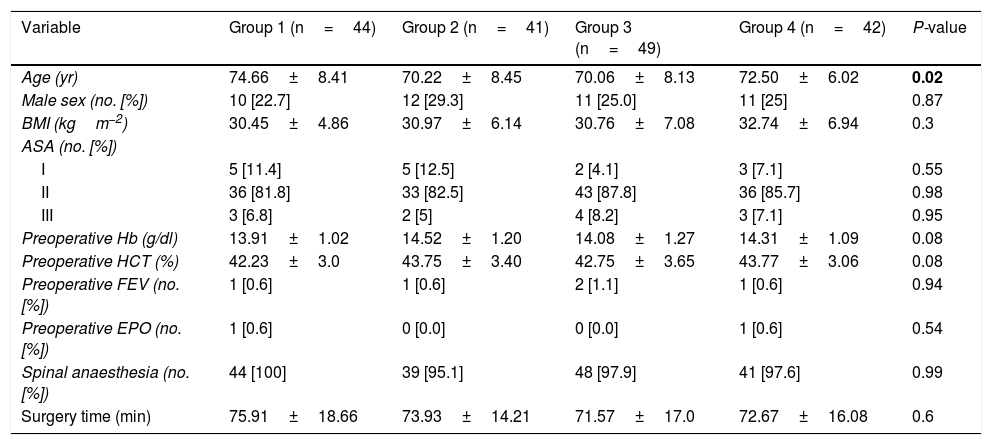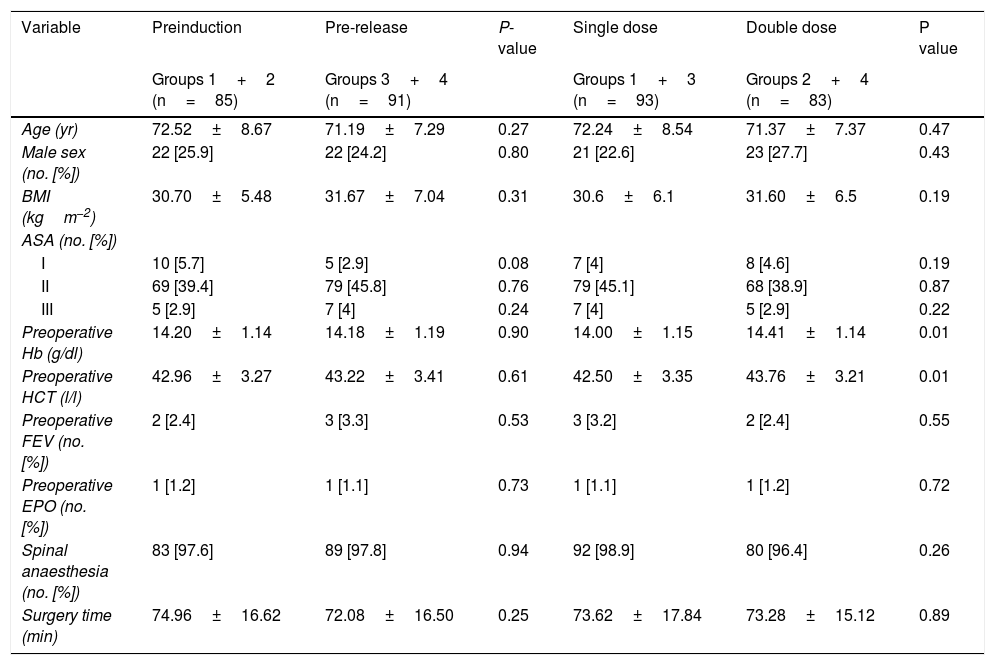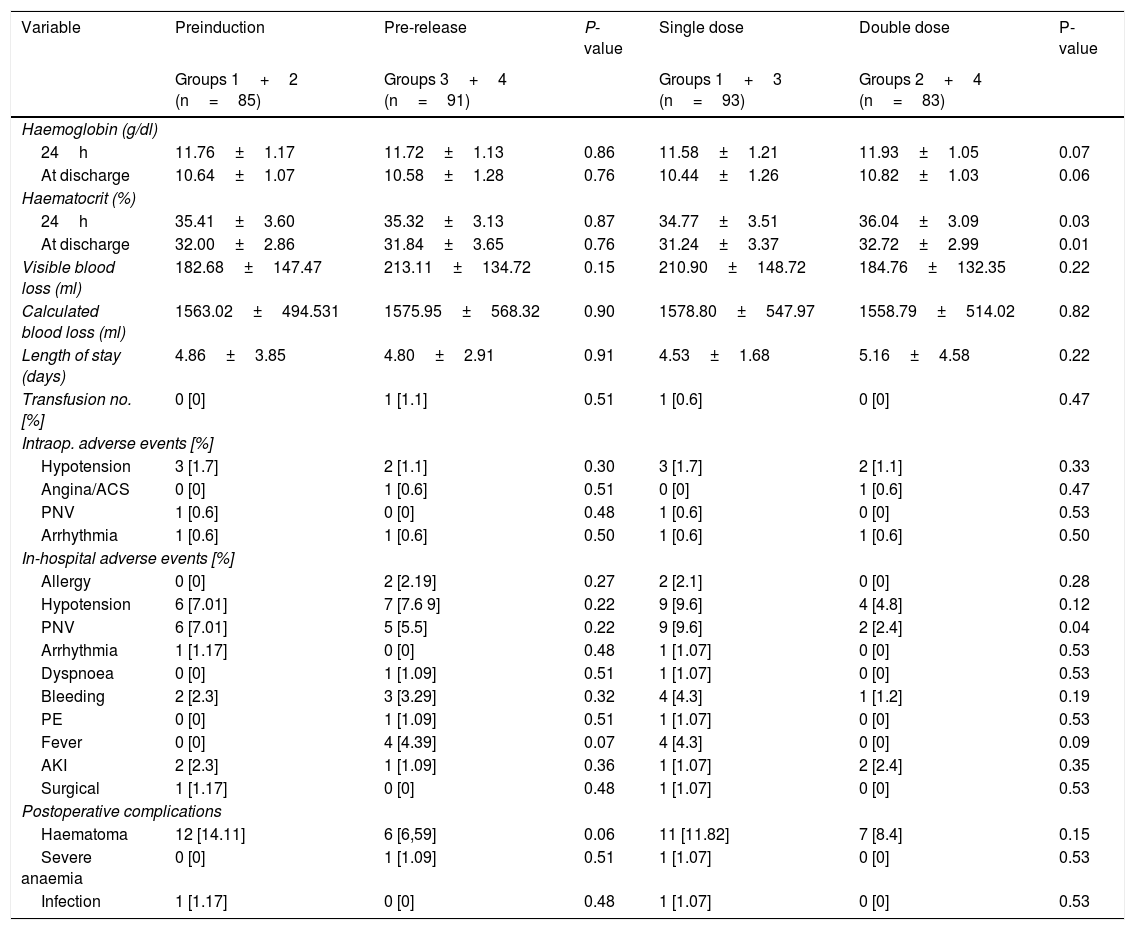The ideal timing of tranexamic acid administration in total knee arthroplasty with tourniquet remains unclear. Our primary objective was to prove if administering it before surgical incision, instead of before releasing the tourniquet, reduces postoperative bleeding. A second objective was to determine whether a second dose reduces post-operative bleeding.
Material and methodsA prospective, double-blind clinical trial was performed on 212 patients scheduled for total knee arthroplasty. They were randomised into 4 groups. Tranexamic acid was administered before the surgical incision in “pre-induction groups” (1 and 2), and just before the tourniquet release in “pre-release groups” (3 and 4). Groups 2 and 4 received a second dose 3h post-surgery. Main outcome was postoperative bleeding (visible blood loss and calculated total bleeding). Secondary outcomes were haemoglobin variations, complications and transfusion rate.
ResultsThe mean calculated total bleeding was 1563ml (95%CI: 1445–1681) in preinduction groups versus 1576ml (95%CI: 1439–1713) in pre-release groups (P=0.9); 1579ml (95%CI: 1452–1706) in single-dose groups versus 1559ml (95%CI: 1431–1686) in double-dose groups (P=0.82). One patient was transfused. The mean haemoglobin at discharge was 10.4g/dl (95%CI: 10.2–10.7) in singledose groups versus 10.8 (95%CI: 10.6–11.1) in double-dose groups (P=0.06).
ConclusionsThere were no differences in bleeding or transfusion regarding the time of tranexamic acid administration. The second dose had not impact on outcomes.
Trial registrationEudraCT 2016-000071-24.
El momento óptimo para la administración de ácido tranexámico en la artroplastia de rodilla con torniquete no está claro. El objetivo principal de nuestro estudio era demostrar si su administración tras la inducción anestésica reduce el sangrado postoperatorio respecto a administrarlo antes de la liberación del torniquete. Nuestro objetivo secundario era determinar si una segunda dosis reduce significativamente el sangrado.
Material y métodosEnsayo clínico prospectivo con 212 pacientes programados para prótesis total de rodilla, aleatorizados en 4 grupos. El ácido tranexámico se administró antes de la isquemia en los «grupos preinducción» (1 y 2) y justo antes de la liberación del torniquete en los «grupos preliberación» (3 y 4). Los grupos 2 y 4 recibieron una segunda dosis 3 h después. La variable principal fue el sangrado postoperatorio (visible y el calculado). Las variables secundarias fueron la variación de hemoglobina, complicaciones y transfusión.
ResultadosEl sangrado total calculado fue 1563ml (IC 95%: 1445–1681) en los grupos preinducción frente a 1576ml (IC 95%: 1439–1713) en los preliberación (p=0,9); los de dosis única sangraron 1579ml (IC 95%: 1452–1706) frente a 1559 ml (IC 95%: 1431–1686) en los de 2 dosis (p=0,82). La hemoglobina al alta fue 10,4 (IC 95%: 10,2–10,7) con una dosis frente a 10,8g/dl (IC 95%: 10,6–11,1) con 2 dosis (p=0,06).
ConclusionesNo se detectaron diferencias en sangrado ni transfusión dependiendo del momento de administración del ácido tranexámico. Una segunda dosis tampoco tuvo impacto significativo.
Registro de ensayo clínicoEudraCT 2016-000071-24.











